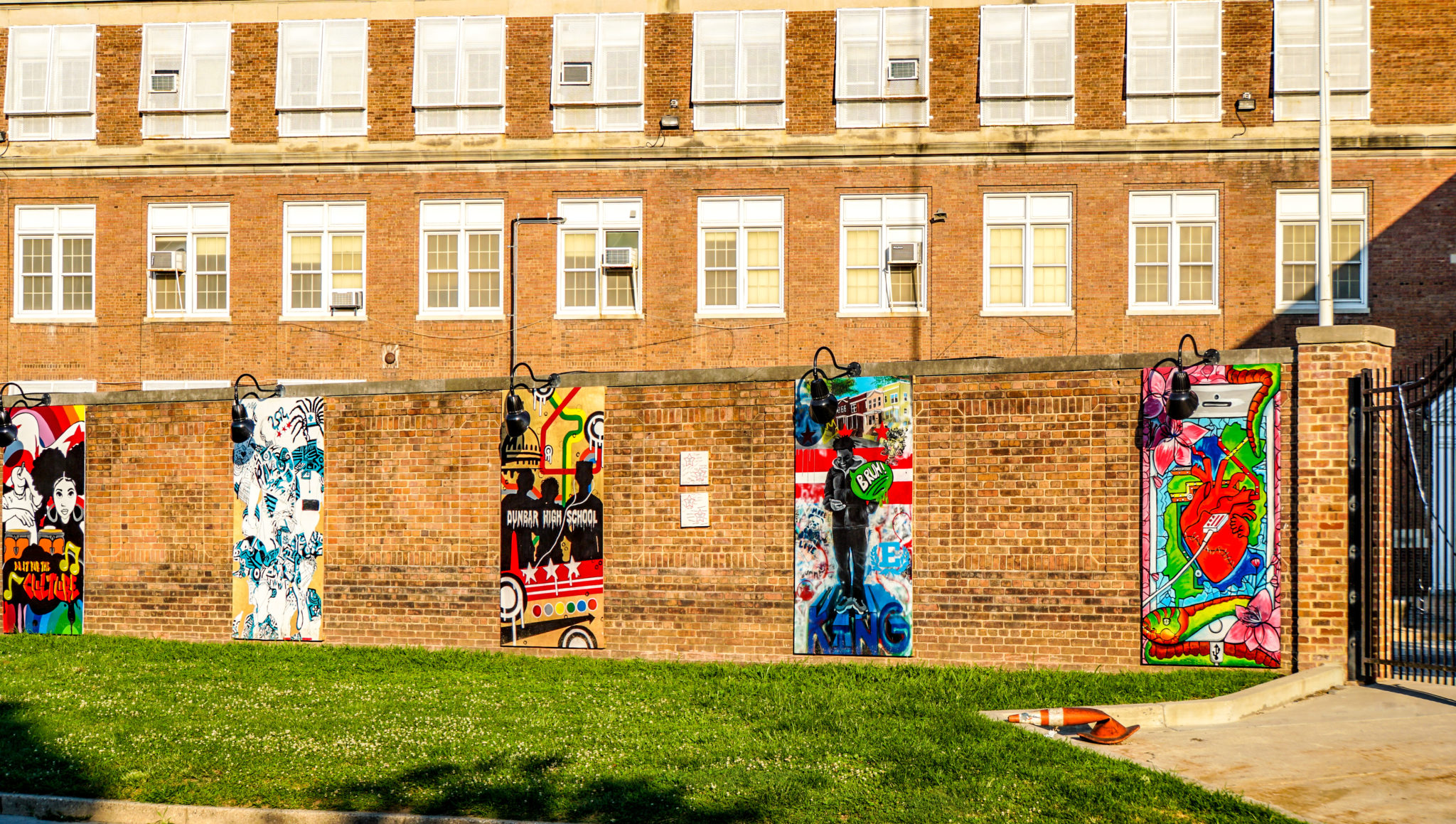How will enrollment in D.C.’s public schools grow? This blog post examines which grade bands are expected to grow the most over the next ten years as a follow up to the D.C. Policy Center report, Will Children of Millennials Become Future Public School Students?.
Public school enrollment in D.C. has been growing since 2010, and signs point to a continued increase in pre-kindergarten through grade 12 enrollment. There are more children born in the District, and more families are choosing D.C.’s public schools (see Two drivers of D.C.’s public school enrollment increase). But by how much will it increase, and in which grades?
This analysis estimates future public school enrollment based on the number of births in D.C., public school enrollment in previous years, and transition rates between grade bands. If current conditions continue, there would be an increase of approximately 21,100 pre-kindergarten to grade 12 students from 2016-17 to enrollment of 104,591 students in 2026-27. Compared to past increases in enrollment, this growth is likely to be especially large in middle school over the next five years and in high school over the next ten years.
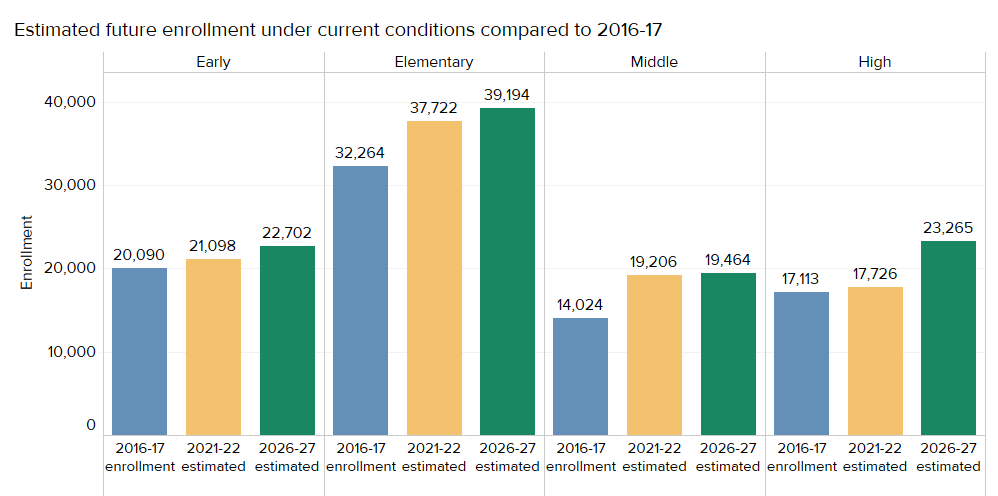

Five-year enrollment estimates
Over the previous five years, enrollment grew by 11,663 students. This growth was strongest in kindergarten and grade 5, and weaker in grades 8 and 12. From 2011-12 to 2016-17, enrollment in kindergarten grew by the most at 1,269 students, and grade 5 enrollment grew by 771 students. Over this same period, grade 8 enrollment grew by only 146 students and grade 12 by 329 students. These enrollment patterns reflect that more families with children are staying in D.C. and its public schools after birth, resulting in larger levels of growth in lower grades. However, these children have not aged into middle and high school in large numbers yet.
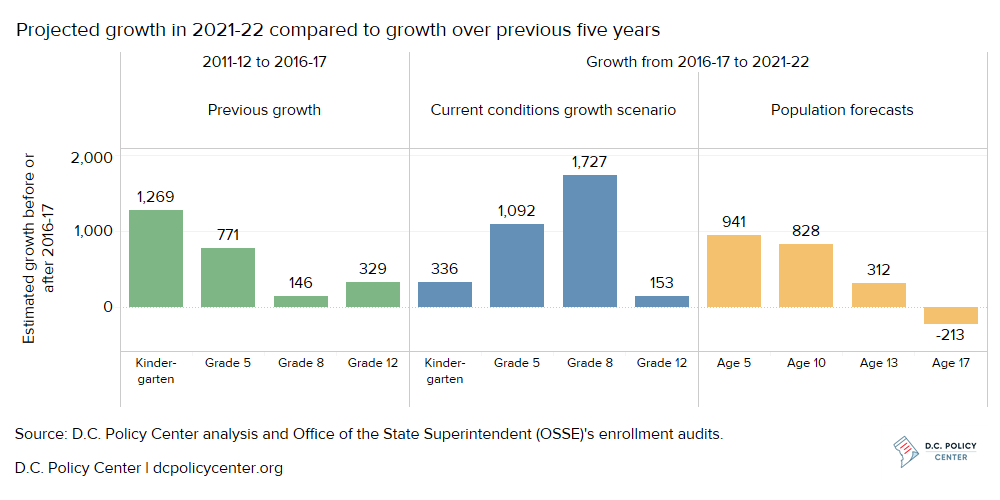

Looking at key entry and exit grades, growth under current conditions would result in some increases in each grade between 2016-17 and 2021-22. If families continue to stay in public schools between grade bands as they have in recent years, D.C.’s public school enrollment will increase by a relatively small amount in kindergarten (about 300 students), by more in grade 5 (about 1,100 students), and by the most in grade 8 (about 1,700 students). Grade 12 would increase slightly (about 150 students). This would represent a shift in which grades are growing – enrollment rose by more students in kindergarten and grade 5 than grade 8 over the previous five years. Compared to the D.C. Office of Planning’s five-year population forecasts, these projections look low in kindergarten and high in other grades.
This grade-by-grade growth could indicate an increase of approximately 12,300 students for all grades (pre-kindergarten through grade 12) from 2016-17 to 2021-22 . This estimate of enrollment increases in all grades extrapolates growth in a single grade to the entire grade band.[1] The total estimated growth over the next five years is similar to the growth over the previous five years (2011-12 to 2016-17), but enrollment growth begins to occur in middle school grades in 2021-22 compared to the increase in early childhood and elementary enrollment that occurred over the previous five years.
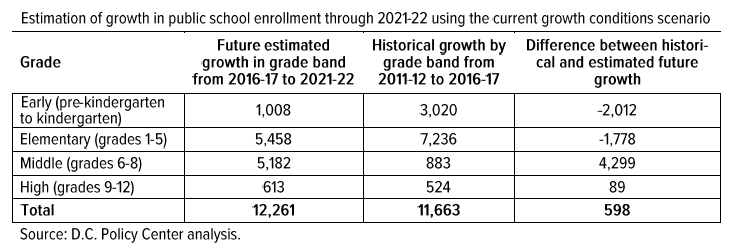
Ten-year enrollment estimates
Over the previous ten years, enrollment grew by 14,402 students. By comparison to more recent years, this growth is largest in early grades. For example, enrollment in the key grade of kindergarten grew by 2,157 students from 2006-07 to 2016-17, which could be related to the expansion of access to free pre-kindergarten in 2008. Enrollment actually decreased over the previous ten years in grade 8 by 468 students, and increased in grade 12 by only 19 students.
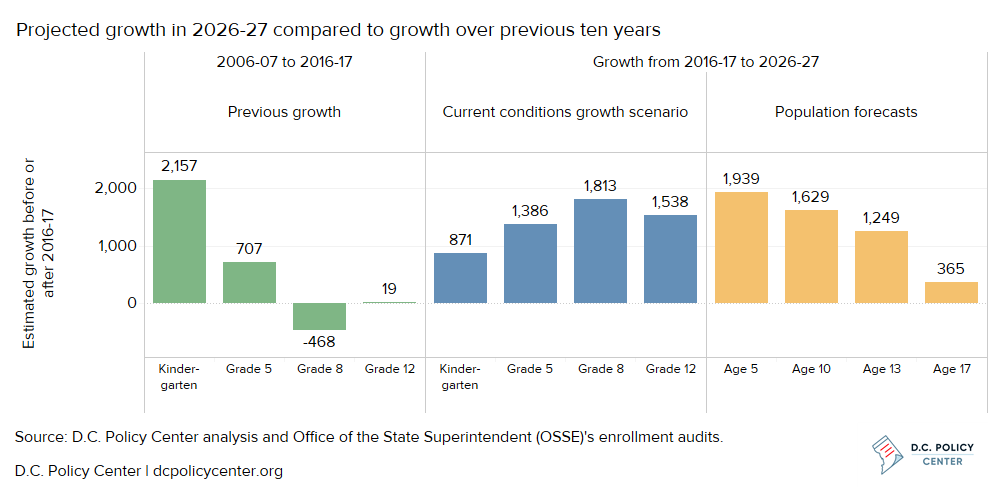

If current conditions continue over 2016-17 to 2026-27, estimates indicate that public schools will add even more students, especially in grades 8 and 12 (about 1,800 and 1,500 students, respectively). This large increase in upper grades would represent a turnaround compared to the past ten years. Enrollment in grade 5 would continue to increase by 1,400 students, and enrollment in kindergarten would slow to 871 students. However, population forecasts indicate that older age groups, especially those aged 17, will increase by fewer children.
Over the next ten years, these growth estimates could mean that public school enrollment grows by a total of about 21,100 students and shifts toward more high school students. This would be a much larger increase than occurred over the previous ten years, especially in middle and high school grades. High school enrollment would grow by about 6,200 students (after shrinking by 1,007 in the previous ten years), and middle school enrollment would increase by about 5,400 students (after decreasing by 713). Growth in pre-kindergarten through kindergarten would slow, which is plausible as D.C.’s schools have already seen a large increase of 8,585 students due, in part, to 80 percent of children born in D.C. staying through early grades in recent years.


Summary
D.C.’s public schools can expect enrollment to increase especially for middle school grades over the next five years, followed by an increase in high school grades over the coming ten years. This means that the city might start to experience higher enrollments in middle and high school grades after seeing it in early childhood and elementary grades over the previous five to ten years. However, current population forecasts do not predict that D.C.’s school-age population will grow as quickly as these estimates do, especially for the cohorts who would attend grades 5, 8, and 12. Still, higher enrollments in upper grades is possible as students are starting to stay in public schools at higher rates in middle and high school grades.
However, for these ten-year estimates to hold, students must stay in public schools through middle and high school at higher rates than they did in 2017-18. In grade 8, 68 percent of children born 13 years earlier need to stay in D.C. and its public schools on net by 2026-27. For contrast, only 56 percent of the comparable cohort enrolled in grade 8 in 2017-18. And in grade 12, 54 percent of children born in D.C. 17 years earlier need to stay by 2026-27 compared to 47 percent of children born in D.C. previously who enrolled in grade 12 in 2017-18. This makes policies that increase the attractiveness of schools to future parents of middle and high school parents critical for continued growth.
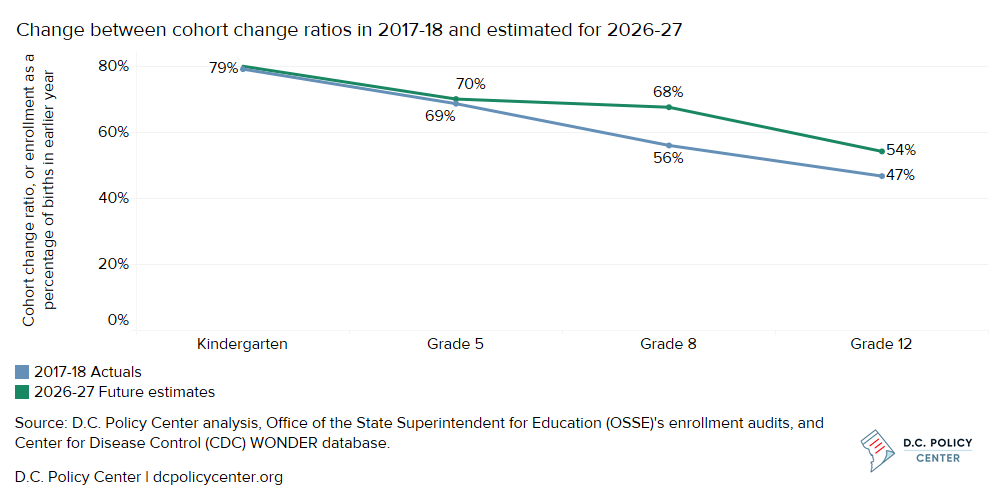

Method
This analysis estimates future public school enrollment based on the number of births in D.C., public school enrollment in previous years, and transition rates between grade bands. The kindergarten estimates use the number of births in 2016 as a base for five-year projections and the number of projected births[2] in 2021 for ten-year projections. For other grades, the five-year projections (for 2021-22) use enrollment in previous years,[3] and the ten-year projections use enrollment projected for 2021-22. The analysis focuses on one grade per grade band (kindergarten for early grades, grade 5 for elementary, grade 8 for middle, and grade 12 for high). Each estimate is compared to previous growth and population forecasts. The current conditions growth scenario assumes that students will transition between grade bands at the same rates they did on average in the most three recent years (2014-15, 2015-16, and 2016-17). Finally, each current conditions growth estimate is extrapolated to an estimate for all grades in its grade band.
Click here to read the full report, download the report as a PDF, or access the data and methodology.
Notes
[1] For example, estimated total growth in elementary school grades (grades 1 to 5 in this analysis) is calculated as the estimated growth in grade 5 (1,092 students) multiplied by the number of grades in the grade band (5 grades) to get growth of 5,458 students in grades 1-5.
[2] The birth projections assume that average annual growth from 2006 to 2016 in births continues at the same rate (see Will Children of Current Millennials Become Future Public School Students for calculations).
[3] Grade 5 for 2018-19 was not available, so this value was projected using average annual growth for the previous three years (see Will Children of Current Millennials Become Future Public School Students) for calculations.
Feature photo by Ted Eytan (Source).
Chelsea Coffin is the Director of the Education Policy Initiative at the D.C. Policy Center
